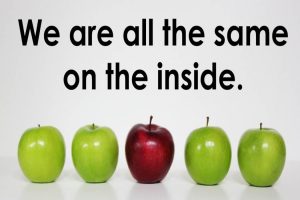Lean, QRM and DDMRP: they’re all the same!

Not long ago, QRM was heralded as the new Lean, and now we are bombarded with DDMRP as the panacea for all our problems. It seems as if the different schools, in their hunger to sell more books, software, and / or advice, put more energy into highlighting the differences than celebrating what unites them. Meanwhile, they leave many an entrepreneur, supply chain professional and process improver behind in despair. Too bad, because believe me, essentially the three schools are all the same.
Of course Lean, Quick Response Manufacturing (QRM) and Theory of Constraints (TOC, the origin of DDMRP) also have fundamental differences. Lean for example advises you to balance your work cells based on takt time and eliminate stocks, while TOC accepts different capacities and promotes time buffers. Lean stresses the importance of waste elimination and value creation, while QRM distinguishes good and bad complexity. TOC wants us to identify and exploit bottlenecks and make the rest subordinate to them. And while Polca is pushed by QRM, Kanban is widely known thanks to Lean. Are you still there?
Many have given up long ago or have never even tried, and keep having unlimited confidence in established techniques like MRP and DRP or just Min / Max and Camp’s formula. Is it not simply a matter of good planning and hard work? Of saying what you do and doing what you say? Which is a pity for them, because in this way they fail to do justice to the achievements of the new schools and more importantly, deny themselves the benefits.
Inability
In his classic “The 5th Discipline” Peter Senge claims that the majority of our problems is the result of our inability to understand the ever growing complexity, let alone cope with it. Consequently, we often limit ourselves to addressing the symptoms, which after temporary relief is usually followed by even greater turmoil. Too often unfortunately, our confidence in resource efficiency, MRP, DRP, Min / Max and Camp is a poignant example of this. With their deceptive simplicity, they seem to promise control but in reality lead to the opposite. A major source of bad complexity and lost productivity of our scarce resources. So watch out!
In the same book a little later, Peter Senge recommends us to really start to understand which forces actually prevent us from achieving our goals. To find our limiting factor. The real source of our complexity. Senge calls this “Systems Thinking”. Brilliant idea! Unfortunately, Senge subsequently fails to guide us in this quest. What to do?
Variability

Should your challenge also lie in improving responsiveness and efficiency, then good old Pollaczek may offer a solution. Pollaczek has taught us that lead time progressively increases with utilisation, especially if the variability in demand and / or process is high. So if we want to structurally improve our responsiveness and efficiency, then according to Pollaczek we only have three options: (1) eliminate waste and (2) bad variability and (3) avoid overload. Or as they say in Japan (1) eliminate muda and (2) mura and (3) avoid muri.
Indeed, you have recognized them correctly. Muda, mura and muri, Toyota’s 3 m’s and the cornerstones of Lean. So Lean actually does not do anything else than try to force breakthroughs by beating Pollaczek! And witnessing TOC’s compelling advice to exploit your bottleneck (1), make the rest subordinate to its drumbeat (2) and avoid overload (3), it is looking into the exact same direction. The same applies to QRM, given its advice to (1) accelerate and preferably eliminate (2) hand-overs and avoid utilisation levels of 80% and more (3).
Breakthrough
So essentially Lean, TOC and QRM are trying to do the same thing: achieve a breakthrough by beating Pollaczek! Only the chosen routes differ, as we can conclude from their very different and by now well-filled toolboxes. Which is not surprising given their very different histories. Lean originated in a high volume / low-mix environment, where investing in highly reliable and balanced flow shops is often beneficial. Kanban, Supermarkets and Heijunka boxes are at their best here.
TOC on the other hand has originated in a low volume make-to-order environment, where process uncertainties and service rate differences are factors that cannot be denied. Time, capacity and stock buffers are important concepts here. Finally, QRM originated in a typical job shop environment that is full of dependencies. This is the world of QRM cells and Polca.
Producing French Fries
Whether you build ships, produce chips, fill oil barrels, maintain networks or develop new products. Whether you pursue either efficiency or responsiveness or both. If you consciously or unconsciously keep denying Pollaczek, there is a big risk that you will keep getting into trouble. But if you recognise the importance of fighting Pollaczek, you cannot avoid the rich toolboxes of Lean, TOC and QRM. Since at their harts, Lean, TOC and QRM are exactly the same. And as long as we realize that we use them as a means, not as an end, they are not each other’s opponents but they supplement each other.


